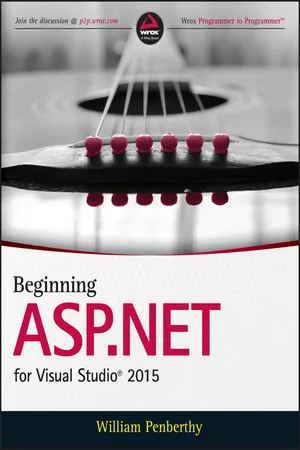
- English
- ePUB (mobile friendly)
- Available on iOS & Android
Beginning ASP.NET for Visual Studio 2015
About this book
The complete guide to the productivity and performance enhancements in ASP.NET
Beginning ASP.NET for Visual Studio 2015 is your ultimate guide to the latest upgrade of this historically popular framework. Fully updated to align with the vNext release, this new edition walks you through the new tools and features that make your workflow smoother and your applications stronger. You'll get up to speed on the productivity and performance improvements, and learn how Microsoft has committed itself to more continuous innovation by increasing its release cadence for all products and services going forward. Coverage includes Async-aware debugging, ADO.NET idle connection resiliency, managed return value inspection, ASP.NET app suspension, on-demand large object heap compaction, multi-core JIT and more.
The news of an off-cycle update to ASP.NET came as a surprise, but its announcement garnered cheers at the 2014 Microsoft BUILD conference. This guide shows you what all the fuss is about, and how Microsoft overhauled the latest ASP.NET release.
- Get acquainted with the new developer productivity features
- Master the new tools that build better applications
- Discover what's new in Windows Store app development
- Learn how Microsoft fixed the issues that kept you from v5
Over 38 million websites are currently using ASP.NET, and the new upgrade is already leading to increased adoption. Programmers need to master v6 to remain relevant as web development moves forward. Beginning ASP.NET for Visual Studio 2015 walks you through the details, and shows you what you need to know so you can get up and running quickly.
Frequently asked questions
- Essential is ideal for learners and professionals who enjoy exploring a wide range of subjects. Access the Essential Library with 800,000+ trusted titles and best-sellers across business, personal growth, and the humanities. Includes unlimited reading time and Standard Read Aloud voice.
- Complete: Perfect for advanced learners and researchers needing full, unrestricted access. Unlock 1.4M+ books across hundreds of subjects, including academic and specialized titles. The Complete Plan also includes advanced features like Premium Read Aloud and Research Assistant.
Please note we cannot support devices running on iOS 13 and Android 7 or earlier. Learn more about using the app.
Information
Chapter 1
Getting Started with ASP.NET 6.0
- A brief history of ASP.NET and why it supports both Web Forms and MVC
- About the two frameworks, Web Forms and MVC
- How to install and use Visual Studio 2015
- The sample application that will be used throughout this book
Code Downloads for this Chapter:
An Introduction to ASP.NET vNext
Hypertext Transfer Protocol (HTTP)

| Name | Description |
| GET | A GET is a request for a resource. It should retrieve that resource without any other effect resulting from taking that action. You sh... |
Table of contents
- Cover
- Table of Contents
- Introduction
- Chapter 1: Getting Started with ASP.NET 6.0
- Chapter 2: Building an Initial ASP.NET Application
- Chapter 3: Designing Your Web Pages
- Chapter 4: Programming in C# and VB.NET
- Chapter 5: ASP.NET Web Form Server Controls
- Chapter 6: ASP.NET MVC Helpers and Extensions
- Chapter 7: Creating Consistent-Looking Websites
- Chapter 8: Navigation
- Chapter 9: Displaying and Updating Data
- Chapter 10: Working with Data—Advanced Topics
- Chapter 11: User Controls and Partial Views
- Chapter 12: Validating User Input
- Chapter 13: ASP.NET AJAX
- Chapter 14: jQuery
- Chapter 15: Security in Your ASP.NET Website
- Chapter 16: Personalizing Websites
- Chapter 17: Exception Handling, Debugging, and Tracing
- Chapter 18: Working with Source Control
- Chapter 19: Deploying Your Website
- Answers to Exercises
- End User License Agreement